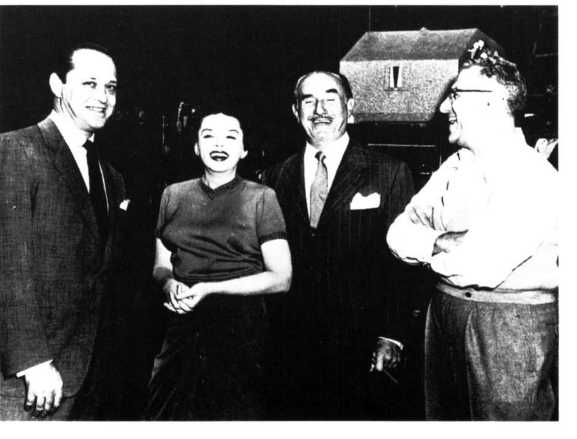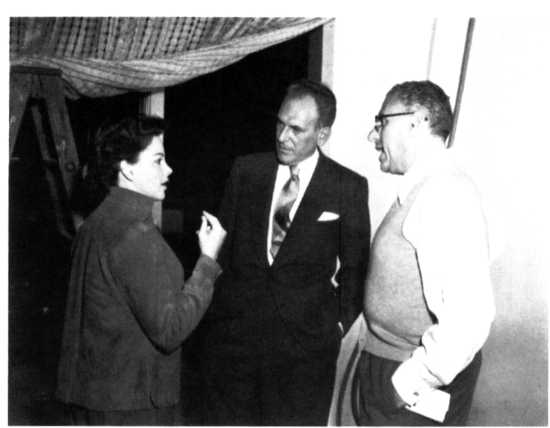A Star Is Born: The Making of the 1954 Movie and Its 1983 Restoration (9 page)
Read A Star Is Born: The Making of the 1954 Movie and Its 1983 Restoration Online
Authors: Ronald Haver
To make sure that his retelling accurately reflected the Garland persona,
Hart had a series of informal conversations with her and Luft regarding
experiences of hers that he might be able to incorporate into the script.
Luft recalls: "We were having dinner with Moss and Kitty [Carlisle], and
Judy was throwing ideas at Moss, cautiously, and so was I. I remember Judy
telling the story of when she was a kid, she was on tour with a band and
they were in Kansas City at the Mulebach Hotel-all the singers and
performers stayed there. And I think her mother ran into a big producer
who was traveling through and she invited him to come and see the act,
and supposedly afterward he was very interested in Judy's career. Nothing
happened, though. Judy thought it would be a kind of a cute idea to lay
onto Moss-that maybe it might be something he could use in his writing."
Several days after this dinner conference, on Christmas Day, 1952, Luft,
Garland, and one-month-old Lorna boarded a cross-country train for New
York, where Garland, as a personal favor to Jack Warner, would sing at a
coming-out party for Warner's daughter Barbara at the St. Regis Roof on
January 3. It was to be a spectacular affair, arranged by ace party giver Elsa
Maxwell, with the cream of New York society in attendance. The Lufts
would stay in a suite at the Waldorf, courtesy of Warner; in return for the favor, Warner would give Garland any gift she wanted. (Hedda Hopper,
in her book The Whole Truth ... and Nothing But; was responsible for
the legend that it was this party and Warner's request that Garland sing
at it that led to the deal for A Star Is Born. Hopper was a good storyteller,
but as a reporter she was inaccurate: the request by Warner was made
several weeks after the contract with Transcona had been signed. Yet the
rumor persists to this day and is soberly reported as fact by otherwise
responsible writers.)
The couple spent a busy holiday hobnobbing with some of their more
intimate chums, including the Duke and Duchess of Windsor, and enjoying a round of parties, capped by Garland's singing at the Warner party.
She was by all accounts a sensation, and in the din surrounding her appearance, Elsa Maxwell extracted a promise to appear on the fifth at another
party she would be giving. On that day, however, in Santa Monica, California, Judy Garland's mother, Ethel, was found dead in the parking lot at
Douglas Aircraft, where she had been a clerical worker. She evidently had
died of a heart attack on her way to work, and her body, wedged between
two cars, had not been found for several hours.
Mother and daughter had been estranged for several years. Mrs. Gumm
seems to have been a classic stage mother, pushing, scolding, and obsessively living her life through Judy. Garland's attitude toward her mother
had undergone a perceptible change in 1939 when, on the anniversary of
her adored father's death, her mother had married a stern autocrat named
Gilmore, whom Garland detested. When the nineteen-year-old Garland
married composer David Rose in 1941, it was as much an escape from her
mother and stepfather's iron rule as it was a teenage infatuation with an
older man.
Early in the 1940s, Mrs. Gilmore had halted the teenage Garland's
much-needed sessions with an analyst, convinced that he would turn her
daughter against her. Later on, in a reversal of her earlier fears of psychiatry,
she sought to have Garland committed to the Menninger Clinic, for which
Garland never forgave her. The final break between mother and daughter
came in late 1949, after a particularly bitter argument during Garland's
separation from her second husband, Vincente Minnelli. Since then Garland had refused to see or speak to her mother and had given orders that
she was not to be allowed near her grandchildren.
A call from Mrs. Gilmore's doctor informed Luft, paged in the Waldorf
lobby, of his mother-in-law's death. The first person he encountered after hearing the news was Elsa Maxwell; when he told her the news, she
implored him to keep it from Garland until after she had sung at Maxwell's
party that night. Appalled at this request, Luft told Garland the tragic news
and the family flew back to Los Angeles for the funeral, while the newspapers made much of Garland's mother working in a menial job while her
celebrity daughter made millions. Afterward, Garland went into a lengthy
seclusion behind the closed doors of her new nineteen-room mansion in
Holmby Hills.
Revolution
 /n January 8, the Hollywood film community was startled by a
/n January 8, the Hollywood film community was startled by a
headline in the Hollywood Reporter: FOX GETS BIG SCREEN PROCESS. Apparently, loth Century-Fox had found a way to make Cinerama practical, for
the article went on to reveal that in December Spyros Skouras, Greek
immigrant, former World War I flier, theater owner, and now president
of Fox, had seen a demonstration in France of a photo device called the
"anamorphoscope," a name derived from the Greek "anamorphose"-to
transform, to form anew. Invented in the late 19205 by Henri Chretien,
it was a cylindrical lens that compressed a picture horizontally by 50
percent; used on cameras and projectors, it provided a picture twice as wide
as the normal motion picture image, while keeping the same height. After
seeing test footage, Skouras, as he later recalled for Life magazine in his
charmingly imperfect English, "in bed that night ... I am dreamin' of
Egyp, of Bens Hur and the Quin of Seba, of Betsy Grabble in colors,
everything on a big screen. Oh, I had wonderful dreams." He immediately
took an option on the lens, beating out a representative from Jack Warner,
who had also heard about it and wanted it for Warner Bros., evidently
sharing Skouras's instinct that it could be marketed as an acceptable alternative to Cinerama.
Tests with the lens were made by Fox in both New York and Hollywood, and after a week of conferences between Skouras and Darryl Zanuck, head of production at the studio, it was announced that henceforth
all of Both Century-Fox's films would be photographed and released
using this new process, which Charles Einfeld, head of Fox publicity,
christened "CinemaScope." Lifting another idea from Cinerama, the system was equipped with four-channel stereophonic sound, tied to the action on the new wide (65 to go feet, depending on the size of the theater
stage), slightly curved screen, which put an image roughly two-and-a-half times as wide as normal in front of the audience. CinemaScope was a
gamble of unprecedented proportions for a major studio: staking $30 million worth of unproduced films on a process that could not be shown in
any theater in the world. Skouras and Zanuck realized that before exhibitors would invest the necessary $25,000 to equip a theater to show
CinemaScope, they would need assurances that there would be a sufficient supply of films to make this investment worthwhile. On January 28,
at a pandemonium-filled press conference in his office at the Fox Studios
in West Los Angeles, Zanuck announced that the first film to be produced and released in the new process would be The Robe, the longpending version of the Lloyd C. Douglas best-seller. The picture had
actually started filming the previous week, but production would now be
shut down and revamped to show off the new technique in a spectacular
fashion. This production would be followed with a comedy called How
To Marry a Millionaire, yet another adaptation of the Zoe Akins play
The Greeks Had a Word for Them, which would star Lauren Bacall,
Betty Grable, and Marilyn Monroe, thereby proving that the use of
CinemaScope need not be confined to spectacles but could be equally
effective with "intimate" stories. All CinemaScope films would be photographed in color, and all would have stereophonic soundtracks. To make
certain that this "revolution" would be accepted throughout the industry,
Zanuck announced that Fox would license to all other producers the use
of the Fox anamorphic lenses and the trade name CinemaScope for a fee
of $25,000 per picture. All this was predicated, of course, on the virtues
of the process, which no one in the world except a privileged few had yet
seen. But Skouras's brother, Charles, president of the huge Fox West
Coast theater chain, didn't need any additional urging; he signed up his
entire three-hundred-theater circuit to show CinemaScope films. To convince the rest of the country's fifteen thousand theaters to follow this
lead, Zanuck announced that mass demonstrations of the process would
be held at Fox's Western Avenue studios in Hollywood in mid-March. By
then, it was hoped, there would be enough rough footage from the first
two films to demonstrate the amazing impact of the system to the dubious and the recalcitrant.
One of the latter was Jack Warner; still chagrined that the Chretien
device had eluded the Warner shield, he was given a private showing of
the test footage by Zanuck, to whom Warner had given his first film job
thirty years earlier. It was at Warner Bros. that Zanuck had made his fame, first as a writer, eventually ending up as vice-president in charge of production. When he and the Warners had a falling-out in 1933, Zanuck had gone
on to form 20th Century Pictures, eventually merging his firm with Fox
Films to form 20th Century-Fox. But he and Jack Warner had stayed
friendly, and they maintained their friendship throughout a series of disputes, recriminations, lawsuits, and rivalries. At the private screening on
February 2, the irony of the moment could not have been lost on the two
men, for it was Zanuck who had been Jack's executive assistant when
Warners had introduced Vitaphone sound in 1926. After the screening,
Warner was complimentary over the process but noncommittal regarding
its use by his studio. The $25,000 fee rankled, as did his resentment at
having been beaten to the CinemaScope punch. Warner decided to wait
and see what developed with his Natural Vision gamble before he committed himself to any other outlays of money.


ABOVE: Janet Gaynor, as
Vicki Lester, filming the
final scene at Grauman's
Chinese Theatre for the
1937 version of A Star Is
Born. RIGHT: Sid Luft, Judy
Garland, Jack Warner, and
George Cukor on October
12, 1953-the first day of
filming.

Judy Garland with Moss Hart and George Cukor.